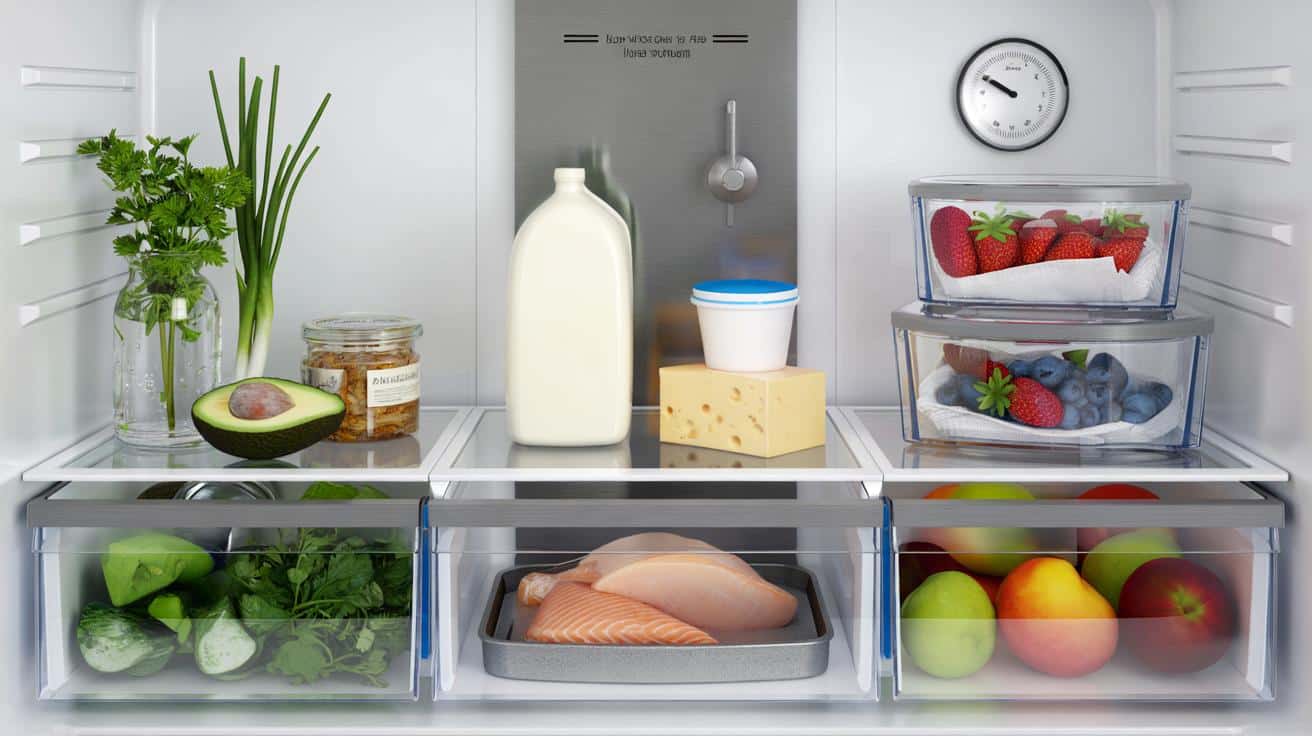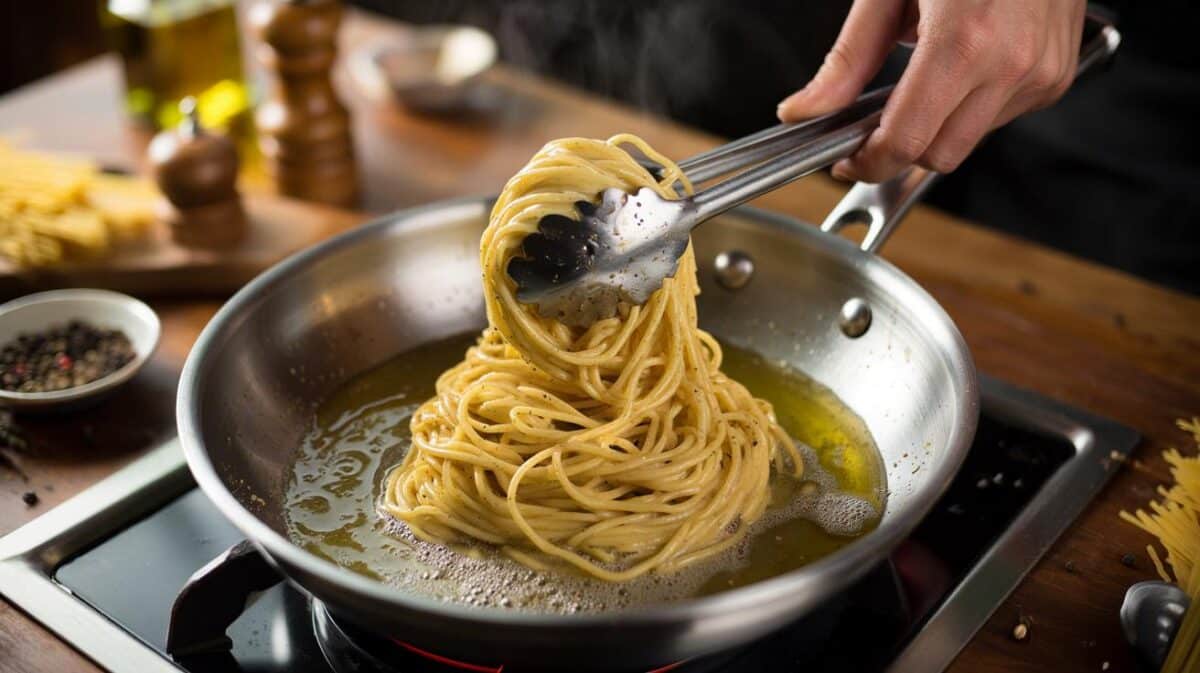We waste food because fridges are chaotic: temperatures vary by shelf, air doesn’t flow, and good intentions get buried. A simple “fridge zone” tweak changes that—keeping food fresh twice as long, and quietly cutting the weekly shop.
No avalanche of yoghurts. No bag of melting salad leaves skulking at the back. Instead, little zones, like lanes on a motorway, with *small, bossy labels*. Milk wasn’t in the door. Herbs stood upright like flowers. A shallow tray sat at eye level that said: “Eat me first.”
We’ve all had that moment when you bin slimy spinach and taste the price of it. Here, nothing looked on the brink. The air felt colder at the back than the front. And every item seemed to have a job. The fix was a zone.
What the “fridge zone” hack is really about
Think of your fridge as a city of microclimates, not a cold box. The door is warm and wobbly. The back is icy and steady. Drawers are humid or dry. The hack is to match the food to the zone it loves, then make that zone obvious so your future self can’t mess it up. Milk goes where it’s cold and stable, not where it’s handy. Leaves breathe in humidity. Raw meat belongs low and contained. When you stop fighting the physics, food simply lasts.
Here’s a real-world snapshot. Before zoning, my berries napped on the top shelf and fuzzed in three days. After zoning, they moved to the “cold stable” back-right in a vented container, and I gave them a quick vinegar rinse (1:3 with water), spin-dry, lined with kitchen paper. They hit day eight still perky. Leafy greens in the high-humidity drawer went from a limp midweek to a crisp end of week. Milk, moved off the door to the middle shelf, stopped turning early. One small re-org created a quiet pay rise for my fridge.
There’s logic under the label maker. Cold air sinks, so the bottom-back tends to be coldest; the door swings, so it fluctuates. Humid drawers slow wilting for greens; low humidity suits fruit that hates moisture clinging to it. The UK Food Standards Agency says fridges should run at 5°C or below, yet many sit warmer. Add a cheap fridge thermometer, map your cold spots, and you’ve got the bones of a system. The rest is traffic control: what goes where, and what you’ll actually stick to at 7pm.
How to build zones in ten unrushed minutes
Start with three lanes. 1) “Ready-to-eat, now” at eye level in a shallow tray—the **Eat-me-first box** for leftovers, ripe avocados, opened jars. 2) “Cold stable” at the back-middle or back-bottom for milk, yoghurt, cooked meats, hard cheese. 3) “Raw proteins” low and contained, ideally in a rimmed tray to catch drips. Then tune the drawers: high-humidity for herbs and leafy veg; low-humidity for apples, grapes, peppers. Pop a cheap thermometer in the back to confirm your coldest bit. Label the shelves, not the food. The fridge becomes a map you can’t ignore.
Common pitfalls are painfully human. We buy on Sunday and hope future us becomes a food stylist. Let’s be honest: nobody does that every day. So make the zones work even when you’re tired. Keep the “now” tray small so it doesn’t turn into a second fridge. Don’t store milk in the door—too warm, too swingy. Don’t stack boxes high at the back; they block airflow and create mini saunas. A quick vinegar wash for berries helps. Fresh herbs last like a bouquet in water, loosely covered, in the high-humidity drawer. Tiny tweaks, big wins.
Here’s what users tell me, in unglamorous, lovely detail.
“I stopped losing salad. That was it. I saved about £8–£10 a week, and my greens went seven days easy. The label ‘Cold Zone’ bullied my milk off the door and it just stopped going weird.”
- Coldest back corner: stash milk, yoghurt, firm cheese. Door is for condiments, not dairy.
- High-humidity drawer: bagged leaves, herbs in a jar, spring onions wrapped in a damp towel.
- Low-humidity drawer: berries in vented tubs, apples, peppers. Line with paper to wick moisture.
- Bottom shelf tray: raw meat/fish in a lipped container. Easy to clean, no drips.
- Eye-level tray: leftovers and opened items. Small on purpose.
- Thermometer check: aim for 4–5°C main cavity; don’t overcrowd or block vents.
Why zoning doubles freshness and trims your bill
A lot of waste isn’t spoilage, it’s entropy. Food drifts into the wrong climate, you forget it, and the bin wins. Zoning fights entropy with friction. Items land in the right conditions by default. You see what has to go first because it sits where your eyes go first. Create a predictable path for milk, greens, berries, leftovers—and you remove a dozen micro-decisions a day. That’s why berries push past a week, herbs live two, and leaves stay bouncey through Friday. Less guessing, more staying fresh.
There’s money in this. WRAP estimates UK families ditch hundreds of pounds of edible food each year. A simple re-layout slashes the “quiet £10” you lose to wilted veg and turned dairy. My own rough tally dropped our waste bin by half a bag a week. Milk lasted the label. Salad made it to pizza night. The fridge felt colder because air flowed. One more nudge: keep a marker pen on the door and write the open date on sauces. Future you won’t have to sniff like a detective.
There’s a tiny amount of setup, not a lifestyle. Clean-out? Fifteen minutes tops. Two clear bins, a tray, and a thermometer. Move milk off the door, set drawers to suit, label the shelves. Then do nothing clever. The system works even when you don’t. Soyons honnêtes : personne ne fait vraiment ça tous les jours. Give yourself slack. The zones hold the line while you get on with life.
Make it yours, not Pinterest’s
Don’t chase a rainbow fridge. Chase behaviour. If your house raids the fridge at 8pm, park fruit pots in the “now” tray. If you batch-cook, give cooked food the colder mid-shelf and don’t stack more than two high. Big shop day? Leave some breathing space; a crammed fridge warms up, then cools slowly, which shortens life. If your model has a meat drawer, use it. If not, a shallow baking tray on the bottom shelf works just as well. The point is consistency, not couture.
Labels matter because they talk to your half-asleep brain. Write them like road signs: “Cold Zone”, “Raw Zone”, “Now”. Keep the **crisper drawer dial** honest: closed for greens (high humidity), open for fruit (low humidity). If your fridge chills unevenly, rotate berries front to back midweek. Herbs in water like flowers, loosely tented with a bag, last oddly long. And if something perishes faster than expected, it’s usually airflow or temperature. A £5 thermometer often pays for itself in one saved chicken.
As one chef friend told me after a long shift:
“At work we don’t think ‘where do I fancy putting this?’ We think ‘what zone keeps it safe and alive?’ Do the same at home, and your fridge stops wasting your money.”
- Quick wins:
- Vinegar rinse for berries (1:3), dry well, vented tub.
- Kitchen paper in the greens drawer to catch moisture.
- Milk off the door, back-middle shelf instead.
- Write open dates on tubs. Future you will smile.
What happens next is the quiet bit
A zoned fridge doesn’t change your life in a day. It changes Tuesday. The leftovers you meant to eat don’t hide behind a jar. The herbs you forgot sit upright and hopeful. You notice what’s ripening because it lives under your nose, not behind a carton. Food hangs on longer, which means fewer mad dashes to the shop, and fewer guilty scrapes into the bin. It’s ordinary magic—physics, labels, and a tiny bit of kindness to your future self. Share it with your flatmate or your mum, and watch how quickly it spreads.
| Point clé | Détail | Intérêt pour le lecteur |
|---|---|---|
| Map the cold and humidity | Back-bottom is coldest; drawers vary by humidity | Put items where they last longest, not where they fit |
| Create three zones | “Now” tray, “Cold stable” shelf, “Raw protein” bottom | Less waste, faster decision-making, safer storage |
| Simple tools | Thermometer, shallow trays, clear labels | Low-cost setup pays back in saved groceries |
FAQ :
- Where should milk go if not in the door?Middle or bottom-back shelf in the cold, stable zone. The door swings and warms, which shortens milk’s life.
- What do I put in the high-humidity drawer?Leafy greens, herbs, spring onions—things that wilt. Close the vent to trap moisture and keep them crisp.
- Do I need fancy containers?No. A shallow baking tray for raw meat, a couple of clear tubs for berries and leftovers, and a £5 thermometer beat a designer set.
- Will this really make food last twice as long?For many items, yes: berries can reach a week, greens a full workweek or more, herbs up to two weeks. It’s about matching climate and reducing temperature swings.
- How often should I reset the zones?Quick tidy when you unpack shopping, and a two-minute scan midweek. That’s it. The labels do the heavy lifting.










Okay, the “Eat-me-first” tray just saved my Tuesday leftovers. Labels are bossy in the best way 😊 Also moved milk off the door—no more early sourness. Thanks!
Does anyone have data beyond anecdotes? “Twice as long” sounds bold. Are there studies comparing door vs back-shelf temps over a week, or is this mostly common-sense tips bundled as a “hack”?